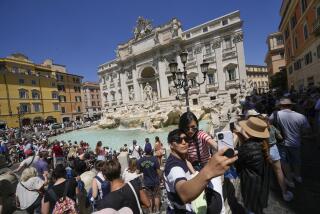It’s Best to Plan Before Taking Off for Paradise
- Share via
Misconceptions about destinations continue to plague travelers who sometimes don’t pay enough attention to what items they should or should not take with them, and what to expect and not expect during their travels.
Enjoying the “paradises” of the world, which includes coping with both culture shock and expense shock, can be greatly enhanced by information and preparation.
A good case in point is Tahiti/French Polynesia, which is likely to receive a lot more promotion with the recent addition of non-stop service from Los Angeles to Tahiti by Air France. Other carriers, including Continental, are also slated to serve this market (which is already served by UTA, Air New Zealand and Qantas).
Here are some pointers on Tahiti/French Polynesia from local tour guides, hotel personnel and tour operators. Many of their tips apply to other destinations as well.
More Than 100 Islands
“People come to French Polynesia and think we only have a few islands,” said Henry Rittmeister, an old island hand. “They don’t realize that there are over 100 islands and that we cover an area larger than Europe.”
American travelers should also keep in mind, Rittmeister said, that Tahiti is not Hawaii. “There is a greater native population here, and it is very much a foreign country. Though many people speak English, French and Tahitian are the languages. Many Americans are also not aware that people here live modern lives. It’s not primitive.”
Distances from the United States represent another misconception, according to Didier Martinot, managing director of the Hotel Sofitel Marara Bora Bora. “Some Americans think Bora Bora is 15 or more hours from Los Angeles, though it’s less than eight hours to Papeete and just about an hour on to Bora Bora.”
It may take you another hour to get to your hotel from the airport in Bora Bora.
Islands have their own personalities, which includes topography. For example, Tahiti, Moorea and Bora Bora are mountainous, while Rangiroa is an atoll with a much flatter terrain.
Lured by attractively priced packages, travelers may not fully realize the extent of incidental costs. Due to high import taxes, the islands are expensive. “Prices are higher than most American travelers realize,” Rittmeister said.
“We recommend that people budget about $50 a day for meals,” said Lynn Ennis, head of Santa Barbara-based Ami Tours.
Add liberally to this sum for any drinks. Beer can cost $4 and a shot of Scotch as much as $8.50 at some hotel bars.
Some of the packages offer the option of meal plans, perhaps breakfast and dinner. However, at some properties you may feel somewhat like a captive at the hotel (though in a beautiful setting) at mealtime. One item to check out is if there is a village or shopping complex nearby where you can eat (and don’t expect any fast-food outlets) or buy food.
You also have to determine if the distance is walkable for you and if the hotel provides transportation, free or otherwise, to these areas. There isn’t much public transportation available, if any, except in Tahiti. Rental cars tend to be on the expensive side. “Figure $50-$55 per day for renting a car,” Ennis said.
As for meal plans, Robin Temaiana of Costa Mesa-based Islands in the Sun suggested: “Buy a meal plan after arrival when you may have a better idea of your situation.”
One couple I met on Moorea had brought a supply of soup packets, prunes and canned tuna to avoid having to eat every meal at the hotel restaurant.
Another point to consider is whether your room will have a refrigerator unit. “Go for the lowest category in the better hotels instead of the highest category in a lesser property,” Temaiana advised. “If you get upgraded, which can happen for a variety of reasons, you have the possibility of a better room.”
With the French influence, meals can be an event. “This is not a fast-food society,” said Franz Ettlinger, food and beverage director at the Moorea Lagoon Hotel. “Americans should be prepared to try some Tahitian dishes. Many visitors have no idea of what Tahitian food is like. It’s good but rich in calories, and you don’t have to be a gourmet to enjoy it.”
Another misconception travelers may have concerns the amount of sightseeing and activities available. The islands, for many visitors, tend to be places more to simply be than to do. “Many people expect to find more activities than there are, both at and outside their hotels,” Rittmeister said. “And they don’t realize to what extent they may be spending most or all of their time at the hotels.”
Temaiana said: “You don’t come here for food or service, but for the beauty, serenity and the sheer magic of the islands.”
Hotel Activities
It’s important to determine what sort of activities are available at your hotel, which of them are free, and what the costs are for those that aren’t gratis that you think you might be interested in. At some properties snorkeling, windsurfing and outrigger canoes might be gratis. Scuba-diving equipment and deep-sea fishing boats are another story.
Many travelers, Rittmeister said, don’t realize just how casual the islands are. “They take too many clothes they wind up never wearing and not enough shorts and T-shirts they do need to be comfortable. You can travel in shorts and eat lunch in shorts, and men don’t need a jacket or tie.”
As you are likely to eat in many open-air dining rooms, having a wrap or Windbreaker are useful, especially during July and August, which is wintertime in French Polynesia.
Bringing one or more strong pairs of sandals that won’t easily fall off and which can handle the coral reefs (a cut can be dangerous) that abound is vital. Plastic sandals are sold in the islands.
Also, it’s worth inquiring if the hotel has a swimming pool in case you don’t want to swim in the lagoons off the islands. Some of the lagoon waters are more swimmable than others.
Rittmeister also counseled to bring plenty of sunscreen as the sun is strong and you can easily run out. The locally made lotions may be of a different strength than you need or are accustomed to. A hat is also essential. No matter how much of a sun lover you may be at home, you are likely to find yourself more exposed to strong sunlight for longer periods than you’re used to.
Bring your own antibiotics. Anything you need might not be available on the outer islands. A supply of insect repellent and a pocket flashlight will also prove useful.
On the subject of currency, check whether there is a bank close to your hotel (which will provide a better rate than the hotel).
“It’s a good idea to exchange the amount of money you think you’ll need at Papeete before heading on to some of the outer islands, where the banks may be less convenient or not available,” said Beatrice Robert-Theis, marketing and sales manager of the Kia Ora Village in Rangiroa.
While tipping is not the norm in French Polynesia, with signs to that effect, you may show your appreciation of service through a gift, which can be money. “But be personal about it,” Rittmeister recommended. “Don’t just leave the money on a table. Give it to the person directly.”
On the inter-island flights, the usual practice is to reconfirm your ongoing flight upon arrival. Don’t wait until close to departure. Bring reading material with you. You won’t find many places to buy newspapers, magazines and books.
More to Read
Sign up for The Wild
We’ll help you find the best places to hike, bike and run, as well as the perfect silent spots for meditation and yoga.
You may occasionally receive promotional content from the Los Angeles Times.






